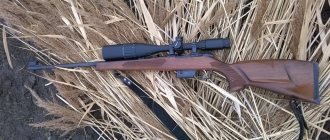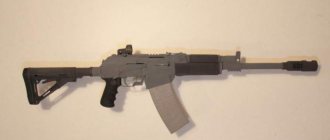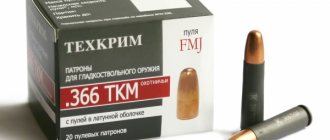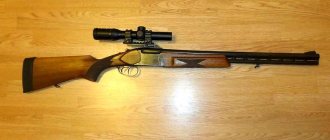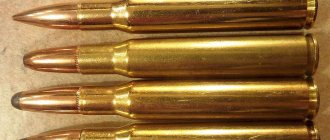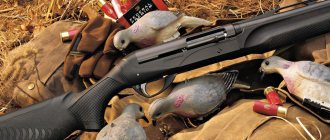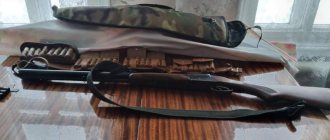This article completes the series on “pseudo-rifling” calibers - previously we wrote about the intermediate caliber .366 TKM and pistol caliber .345 TK, and now it’s time to deal with the “rifle” caliber 9.6x53.
It can be a stretch to call it a rifle, since it is intended for nominally smooth-bore weapons, but both in its form factor and in energy it corresponds to the typical classic rifle caliber 7.62x54, on the basis of which it was developed.
Moreover, the 9.6x53 caliber was developed in conjunction with weapons with oval-screw drilling and gave birth to a whole class of Lancaster barrels, which can now be found on weapons of other calibers. We wrote in detail about Lancaster drilling in this article.
Design of the VPO-222 carbine
The automatic operation of the carbine works by removing powder gases through a hole in the barrel wall, directly acting on the gas piston, which retracts the bolt group. The barrel bore is locked by turning the bolt with two protrusions in the longitudinal grooves of the receiver.
A trigger-type trigger allows firing only single shots. The gun's firing pin is spring-loaded to prevent accidental discharge when dropped on hard surfaces. The design includes a mechanical safety device located on the right side of the carbine. The trigger mechanism from the RPK, designed for 7.62 mm cartridges, was converted to the powerful 9.6x53 mm Lancaster cartridge without major reworking of the mechanism design. In order to increase safety when handling the gun, an additional safety lever was introduced behind the main safety lever. This solution makes it possible to more reliably restrain the firing pin from accidentally puncturing the primer.
The cartridge is developed on the basis of 7.62x54 mm military ammunition and has a 9.6 mm caliber bullet. This type of ammunition is used for hunting large animals, less often medium ones.
The muzzle energy of the cartridge is about 4 thousand Joules, which is comparable to the power of a large-caliber military rifle.
That is why, in some cases, carbines chambered for Tekhkrim cartridges are also used for military purposes. Owners of weapons chambered for this cartridge like that the cartridge is reusable, that is, it can be reloaded independently.
The barrel, as in the previous model, is made by cold rotational forging. The inner surface of the barrel has an oval-circular Lancaster drill with chrome plating on the inner surface. This solution, coupled with the smooth walls of the barrel, eliminates excessive friction of the bullet at the moment of firing, increases the reliability of the barrel in particular and the design of the carbine as a whole. A muzzle brake is installed at the end of the barrel - a compensator; if necessary, it can be dismantled to install other muzzle devices. It is not recommended to shoot without a compensator or other device installed - the recoil will be too strong, and the accuracy of the hit will be much lower.
The barrel length varies in four sizes - 420, 520, 590 and 700 millimeters. The VPO 222 00 420 mm shotgun is the most compact and weakest in the series.
Sights are represented by classic sector rear sights, designed up to three hundred meters, and a front sight mounted on the end of the gas block. On the left side of the receiver there is a dovetail mount for mounting various optical sights, including night or infrared. The carbine is not intended for long-distance sniper shooting, so the optimal firing range can be considered 100-150 meters. In addition to the side rail, there is a Picatinny rail on the receiver cover, which allows the installation of almost any suitable foreign-made sights.
The cartridges are fed from removable magazines designed to hold five rounds of 9 mm Lancaster caliber. There is only one magazine in the kit, so experienced hunters immediately worry about buying two or three more magazines.
Features and characteristics of caliber 9.6x53 Lancaster
The 9.6x53 caliber appeared as a development of the idea of the .366 TKM cartridge, but with more energy - for hunting medium and large ungulates. The problem was the high power of the cartridge - a short section of paradox in a smooth barrel did not have time to stabilize the fast bullet, and it was torn off the rifling. Thus was born the idea of using the long-forgotten oval-screw rifling of the Charles Lancaster barrel with a new cartridge, and it itself is often referred to as 9.6x53 Lancaster.
The 9.6x53 cartridge is assembled in a 7.62x54 case according to the same principle as the .366 - the bottle sleeve is flared, then it is trimmed by 1 mm, and a bullet with a real diameter of 10.3 mm is pressed into it. Also, the shoulders of the case are slightly lowered in order to eliminate the interchangeability of calibers and prevent the use of a 7.62x54 rifled cartridge in smooth-bore weapons.
stages of sleeve transformation
The ballistic indicators of the caliber on the popular lightweight FMJ 15 bullet are approximately as follows:
- Speed - 710-750 m/s
- Energy at the muzzle - 4100 J
- Energy at a distance of 100 meters - 2600 J
- Accuracy at 100 meters (520mm barrel) - 1.4-2 MOA
As you can see, the caliber does not lack in power and accuracy; in all respects it is quite suitable for the role of a hunting cartridge for large game.
Unfortunately, not everything is so rosy - like all other “pseudo-rifling” calibers, the 9.6x53 has a strong drop in the bullet’s trajectory. Yes, it has a longer range than .366 TKM, but even for 250 meters the vertical corrections will be about 50 centimeters, and at a distance of 300 meters the bullet drops by almost 1 meter! Taking into account the loose load of gunpowder, as well as weather conditions, we can only seriously talk about effective shooting distances of up to 200 meters, and then the lottery begins.
However, as experience shows, for most types of hunting this is a completely exhaustive distance, and only athletes and lovers of high-precision shooting can objectively complain about the insufficient working distance of the shot.
Care and maintenance
Every professional hunter knows that it is necessary to keep a gun clean. Yes, the spaced parts of the trigger mechanism allow the Vepr 1B 9 6 53 Lancaster carbine to go without cleaning for a long time, but who knows when the moment will come when the gun will simply jam or misfire? Therefore, it is recommended to clean the rifle after each hunt at the end of the day. To do this, you need to unload the gun (disconnect the magazine and make sure there is no cartridge in the chamber). Having cocked the bolt and pulled the trigger, you can begin further disassembly - you will need to fold the stock, press its hook towards the receiver and turn the shoulder rest until it clicks.
It is forbidden to fold the shoulder rest when the carbine is cocked - this can lead to damage to the trigger mechanism.
Having folded the buttstock, you need to dismantle the optical sight (if one is installed) and, pressing the receiver lock, separate its cover upwards. Having separated the cover, you need to remove the return spring along with the locking rod, and carefully pull out the bolt group - the gas piston and the bolt. Prepare a cleaning rod with a wipe and a solution for cleaning the barrel - you need to clean the barrel until it returns to its original shine. Those parts that you removed must be cleaned from traces of powder deposits using a rag and a weapon cleaning solution and the system must be reassembled after lubricating it. Once assembled, check the functionality of the gun by cocking and unloading it several times by pressing the trigger. Assembly is carried out in reverse order.
Ammunition in 9.6x53 Lancaster caliber
FMJ 15/18
Cartridge 9.6x53 Techkrim Lancaster FMJ15 57 ₽
Cartridge 9.6x53 Techkrim Lancaster FMJ15
Licensed product Not delivered to TC
Add to cart
Jacket bullet weighing 15 and 18 grams, respectively. Both fly well and have excellent penetration ability. Suitable for hunting medium and large game, as well as for sport and recreational shooting. This ammunition also has a US version - with a reduced velocity, for hunting small animals.
SP 18
Cartridge 9.6x53 Techkrim Lancaster SP18 63 RUR
Cartridge 9.6x53 Techkrim Lancaster SP18
Licensed product Not delivered to TC
Add to cart
A standard semi-jacketed bullet with the most balanced combination of penetrating and stopping action. Suitable for hunting medium and large game, as well as for training shooting.
Kion
Cartridge 9.6x53 Techkrim Lancaster Kion 18 60 ₽
Cartridge 9.6x53 Techkrim Lancaster Kion 18
Licensed product Not delivered to TC
Add to cart
Semi-jacketed bullet with controlled expansion. It has excellent ballistic characteristics - its dispersion diameter is only 35 mm. In addition, bullet expansion is ensured at distances of up to 150 meters, which is more than enough for most hunts. Suitable for large animals and predators, as it stops the target perfectly.
Buckshot
Cartridge 9.6x53 Techkrim Lancaster buckshot 8.0 42 ₽
Cartridge 9.6x53 Techkrim Lancaster buckshot 8.0
Licensed product Not delivered to TC
Add to cart
Quite an unusual ammunition, a dense plastic container containing 5 buckshots with a diameter of 8 mm. After leaving the barrel, the container opens, and the buckshot is slightly dispersed by centrifugal force into a sheaf that confidently hits targets at distances of up to 50 meters. Such ammunition is suitable for hunting small game, since the energy of individual buckshot will be significantly lower than that of a bullet, which means the wound channel will be smaller.
Swift
Semi-jacketed bullet with an expansive cavity and concentric petals. It has an excellent stopping effect even at extreme distances - the expansive cavity opens at distances of up to 150 meters. Recommended for hunting big game and predators. The cartridge is completely new, and at the time of writing this article has not yet gone on sale.
Fraction
A shot cartridge similar to that in the .366 TKM line of cartridges. The polymer capsule contains 18 grams of shot No. 7. Not the most popular ammunition, since when accelerated along an oval rifled barrel, the shot sheaf has strong dispersion, and the effective range of such a cartridge is 10-15 meters. However, situations are different, and it can be useful to have a dozen of these cartridges on hand when hunting.
Gun tuning
The manufacturer has invested a lot of work in increasing the reliability of the mechanism and the power of the shot, but the VPO 222 01 L 520 mm carbine (along the barrel) has practically no possibilities for tuning. To put it simply, the entire process of tuning and setting up a weapon is just the installation and zeroing of various sighting devices, the rest - changing the forearm to an ergonomic one, replacing the butt, pistol grip to an anatomical one, installing custom trigger mechanisms - is not available in this carbine.
What is a Lancaster drill?
This type of rifling is often called oval-helical, due to the fact that when you look into the barrel, it seems that it is oval, imagine a smooth barrel, and inside, opposite each other, there are two semicircular rifling, which go deep in a spiral in turns, this is very resembles a regular rifled barrel.
This type of drilling was used until the beginning of the 20th century, and was developed in the mid-19th century, in 1850 to be precise. The idea was to charge two charging guns more easily; when using such drilling, the charge speed increased due to less friction than with traditional threading in the barrel, but later this drilling was replaced by guns with a breech-loading principle.
In the 20th century, weapons with this type of barrel did not become popular, despite the fact that they combined good shooting characteristics. At that time, weapons were produced in single copies for true connoisseurs.
This continued until 2022, until two and Molot Armz produced the 9.6*53 cartridge and weapons for it. Experimenting, the technologists initially made a barrel with a “paradox” drill. But due to the power of the cartridge, it was torn off from this type of drill. Then they decided to use a Lancaster drill, and they were right. And also, thanks to gaps in the legislation, this type of drilling does not apply to threaded drilling. They managed to create a weapon with excellent characteristics: convenient, pleasant, and comfortable to shoot. It disassembles quickly, without difficulty. The weight and size are close to optimal, and in terms of shooting quality it is not inferior to rifled versions.
The parameters that are clearly expressed in the above-mentioned rifle are accuracy and range, and all thanks to a well-made trigger mechanism. It is made on the basis of the older brother of the smooth-bore self-loading gun - VPO-213-19. Another most important positive factor is operational reliability, and all this is because the basic principles of operation were taken from the most reliable RPK-74. For this reason, you will not encounter any failures or misfires. The rifle is also very resistant to external influences. This advantage will be appreciated by shooters in our climate, where winters are cold and frosty, and autumn and spring are rainy. But confidence in a shot also depends on these parameters.
